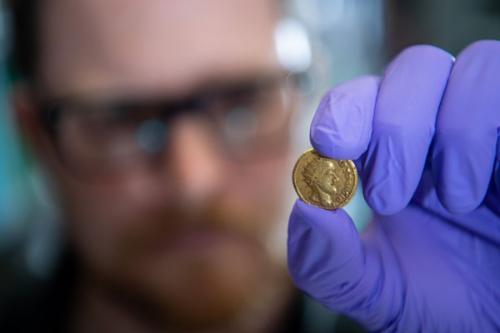Hunterian coins reveal lost Roman Emperor
Published: 23 November 2022
New research on ancient gold coins from The Hunterian collection at the University of Glasgow has revealed a long-lost Roman Emperor named Sponsian.
New research on ancient gold coins from The Hunterian collection at the University of Glasgow and the Brukenthal National Museum in Sibiu, Romania, has revealed a long-lost Roman Emperor named Sponsian.
In a recently-published academic paper, the team behind the discovery uncovered evidence that the coins, long dismissed as forgeries, are authentic.
The coins come from a small hoard of Roman coinage unearthed in Transylvania in 1713. Over the decades, they found their way into collections around Europe, including Dr William Hunter’s, whose 1783 bequest established The Hunterian. The four coins in Glasgow have remained hidden in wooden cabinets until now.
 Three of The Hunterian coins depict recognised Roman emperors: Gordian III (r.238-244 CE) and Philip I (r.244-249 CE). The fourth shows Sponsian, a figure known only through this extremely rare issue bearing his image and name.
Three of The Hunterian coins depict recognised Roman emperors: Gordian III (r.238-244 CE) and Philip I (r.244-249 CE). The fourth shows Sponsian, a figure known only through this extremely rare issue bearing his image and name.
Transylvania, in modern Romania, was once part of the Roman Province of Dacia which was prized for its gold mines. Archaeological studies have established that the area was cut off from the rest of the Roman empire in around 260 CE. Surrounded by enemies, Sponsian may have been a local army officer forced to assume supreme command during a period of chaos and civil war, protecting the military and civilian population of Dacia until order was restored, and the province evacuated between 271 and 275 CE.
Coinage has always been an important symbol of power and authority. Recognising this and unable to receive official issues from the mint in Rome, Sponsian seems to have authorised the creation of locally produced coins, some featuring his own image, to support a functioning economy in his isolated frontier territory.
When the coins were discovered in the early 18th century, they were thought to be genuine and classed alongside other imitations of Roman coins made beyond the fringes of the empire. However, from the mid-19th century, attitudes changed. Coins from the hoard were dismissed as fakes because of the way they looked, with crude, strange design features and jumbled inscriptions.
This has been the accepted view up to the present day. However, no institution had ever subjected the coins to scientific analysis. This was undertaken at the University of Glasgow. Results demonstrated that the four Hunterian examples were used in active circulation and then buried for a considerable amount of time.
Only four coins featuring Sponsian are known to have survived to the present day, all apparently originally from the 1713 hoard. Another is in Brukenthal National Museum in Sibiu, Romania, where researchers have re-assessed it in the light of the new discoveries from Glasgow. High magnification microscopic analysis performed there has revealed similar evidence of authenticity.
With this new understanding, Sponsian can finally claim his place as a ‘lost emperor’ of the Roman era.
Lead author of the paper, Paul N Pearson, UCL (University College London), said:
“Scientific analysis of these ultra-rare coins rescues the emperor Sponsian from obscurity. Our evidence suggests he ruled Roman Dacia, an isolated gold mining outpost, at a time when the empire was beset by civil wars and the borderlands were overrun by plundering invaders.”
Curator of Numismatics at The Hunterian, Jesper Ericsson, said:
"This has been a really exciting project for The Hunterian and we’re delighted that our findings have inspired collaborative research with museum colleagues in Romania. Not only do we hope that this encourages further debate about Sponsian as a historical figure, but also the investigation of coins relating to him held in other museums across Europe."
The interim manager of the Brukenthal National Museum, Alexandru Constantin Chituță, said:
"The collaboration with our partners was particularly pleasant and interesting. For the history of Transylvania and Romania in particular, but also for the history of Europe in general, if these results are accepted by the scientific community, they will mean the addition of another important historical figure in our history. Moreover, it is a wonderful thing for the Brukenthal National Museum, because the museum in Sibiu, Romania is the holder of the only known coin belonging to Sponsian from the territory of Romania. I would like to express my gratitude to the colleagues from the Brukenthal Național Museum - History Museum Altemberger House and especially to the leader of the scientific team, Professor Paul N Pearson, from UCL (University College London) for their commitment, hard work and their impressive result."
The four gold coins are now on display in the Hunterian Museum at the University of Glasgow. The coin in the Brukenthal National Museum will also be on public display.
A special Hunterian Friday Focus Online Talk about the discovery will take place on Friday 2 December at 1.00pm via Zoom.
The Hunterian Museum is open Tuesday–Sunday, 10.00am–5.00pm. Admission free.
First published: 23 November 2022
<< News

